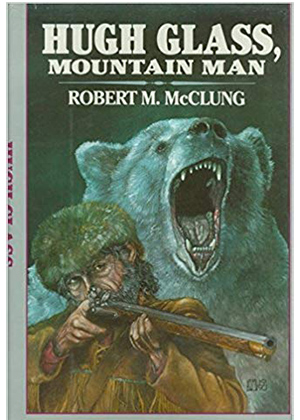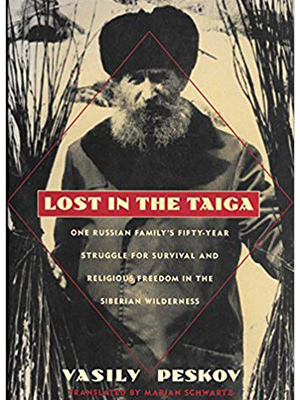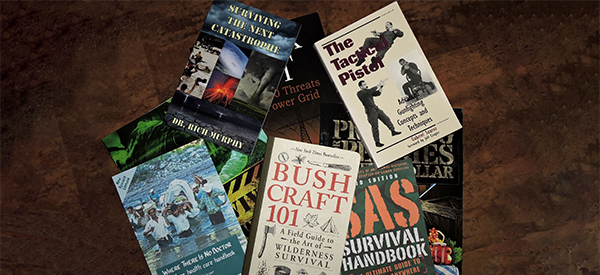Many survivalists I know are voracious readers. Whether we read online or we read actual books, we love to read. We read because we want to learn. We are all aware of the fact that everything we need to know in order to survive is written somewhere in a book.
I don’t know what type of reader you are or how you like to learn new things, but I find that what works best for me is learning from a narrative, rather than from a factual book. A well written fiction, belonging to someone who knows the lessons they want to convey, can impart more knowledge than some dry textbook.
That’s because of the emotions they generate, which help us remember things easier. There’s just no way for a textbook talking about how to survive an earthquake to convey the fear of feeling the earth move up and down beneath you. But the narrative of someone who has survived one can.
When we seek to increase our knowledge of survival, seeing how other people lived and survived certain disasters definitely helps. For instance, when I was younger I learned a lot about living in the wild from reading Louis L’Amor’s books about the Old West. Even though they were novels, the author had ridden the trails he wrote about and knew how to live in the wild, just like the characters he wrote about did.
The best books are those written by people who went through harrowing survival situations and lived to write about it. Even though these books will also talk about the mistakes they made, we can still learn a lot from their mistakes too.
The books listed below are some of the best stories out there about survival. Some are pure novels, while others are stories about real life experiences that real people had. We can use all the books I’ve chosen to learn valuable lessons. This way when it’s our turn to survive, we will be ready.
One Second After
 William Forstchen’s acclaimed story about post-EMP America is probably the best, and best known modern post-disaster novel around.
William Forstchen’s acclaimed story about post-EMP America is probably the best, and best known modern post-disaster novel around.
It is clear from his description of the events in that small North Carolina town, that the author has a very clear understanding of the effects of an EMP.
We see this played out through the life of the main character, his family and the small town he lives in.
With the potential threat of an EMP being one of the biggest existential threats facing us today, “One Second After” is a must-read for anyone interested in survival. While the author’s focus is more on community survival than personal survival, he gives a very accurate depiction of what it will be like to live in a post-EMP world.
One Year After
“One Year After” is the sequel to “One Second After”, taking up the story where the first book ends. In this book, the focus is on the town and its neighbors working to restore lost technology, using information found in the basement of the library. It gets more political than the first book, as the central government is not in favor of their local efforts to self-govern.
The Final Day
This is the final book in Forstchen’s trilogy. This book segues the story from one of survival to a political fight between the locals and the central government that wants to control them. While it doesn’t really talk about survival all that much, it does give additional insight into what may survive an EMP and how we could use it to restore our crumbled society.
Adrift: Seventy-Six Days Lost at Sea
 This classic deals with the true-life story of Steven Callahan, who was put adrift six days into a sailing trip on a sloop.
This classic deals with the true-life story of Steven Callahan, who was put adrift six days into a sailing trip on a sloop.
Once his sailboat capsized, Callahan stayed afloat in an inflatable raft for more than a month. He is the only man to ever survive such an ordeal.
While “Adrift” predates most of today’s action adventures, it brings an element of truth that can only come from real-life experience.
Desperate Passage: The Donner Party’s Perilous Journey West
Nobody can study the American West and the push to settle the western part of the country, without running into the story of the Donner Party, a pioneers group traveling west by wagon train.
Taking a new trail, which had supposedly been thoroughly scouted, they found themselves caught in the mountains, with winter snows falling. Their struggle to survive that first winter caused most of the party to turn to cannibalism, eating the bodies of those who died.
The lessons to be learned from this book come from the mistakes the party made and the mishaps that befell them. Perhaps without the mistakes, they could have survived the mishaps; but regardless, only 48 of the original 87 members reached their destination in California.
Related: What the Pioneers Stockpiled To Survive Winter
Hugh Glass
 Hugh Glass was a mountain man who got into a disagreement with a grizzly bear, surprising her and her cubs. Greatly injured, he was left for dead by his companions, yet remarkably survived.
Hugh Glass was a mountain man who got into a disagreement with a grizzly bear, surprising her and her cubs. Greatly injured, he was left for dead by his companions, yet remarkably survived.
He set his own (broken) leg, treated his injuries as best he could and started crawling to the nearest settlement, at Fort Kiowa, over 200 miles away.
As he traveled, he sustained himself with roots and berries. Reaching the Cheyenne River, he made a raft and floated down to the fort.
The majority of the book is about Glass’ desire for revenge, which he never received. Yet his remarkable story is a testimony of what one can do, injured and in desperate condition. Glass is an inspiration to anyone who reads his story.
Related: How to Survive a Bear Attack
27 Hours: Between a Rock and a Hard Place
Aron Ralston was an experienced outdoorsman who experienced what nobody should ever have to. Out on a solitary hike through a remote Utah canyon, he dislodged a 800 pound boulder that trapped one of his arms against the canyon wall. Over the next few days, the flesh of that arm died.
Five days later, still trapped, Ralston was sure he was about to die. Then inspiration hit him and he broke the now dead bone in his arm and amputated it with a dull pocket knife. This allowed him to find his way back to civilization and survive.
If anything, this book shows the lengths that us humans can go to, in order to save ourselves. While Ralston made many mistakes, including not telling anyone where he was going, he was still able to save his own life, albeit at the cost of his right forearm and hand.
Little House on the Prairie
Laura Ingram Wilder’s series about life on the American frontier may not seem much like a series on survival, but it is filled with insight into how the American Pioneers survived on the Great Plains.
Through these books, countless people have become aware of our country’s pioneering spirit and background. But to you and I, they contain timeless lessons about overcoming nature and danger to survive in the midst of poverty and hardship.
Endurance: Shackleton’s Incredible Voyage
 “Endurance” was the name of Sir Ernest Shackleton’s ship, which was on a journey of exploration in the South Atlantic.
“Endurance” was the name of Sir Ernest Shackleton’s ship, which was on a journey of exploration in the South Atlantic.
Trapped in the ice in October 1915, the ship was crushed, leaving its crew stranded on the ice pack. Left to fend for themselves in one of the world’s most hostile regions, they survived.
Shackleton and his men managed a 1,000 mile voyage in an open boat, as well as an overland trek through glaciers and mountains. Amazingly, they survived and lived to tell their tale.
This is perhaps one of the most dramatic stories of survival there is.
The War Within
The German siege of Leningrad was one of the longest in the history of warfare. Certainly one of the longest in modern warfare, it lasted 872 days.
This book is a collection of writings, gathered from 125 personal diaries. Through the writings of these unknown authors, we see the struggle that ordinary citizens had to survive in a world at war.
Lost in the Taiga
 Harried by religious persecution, the Lykov family head into the Taiga, the great forests of Siberia in 1936.
Harried by religious persecution, the Lykov family head into the Taiga, the great forests of Siberia in 1936.
Moving through the forest, they build a succession of dwellings, before finally settling in the place which would become their home.
For the next few decades nobody bothers them, until they are discovered in the late 1970s, by a Russian pilot who was flying in a geological survey team.
The story of this family is truly inspiring. They survived on very little, as they built themselves a new life, far away from the only home and the only civilization they had known. Their devotion to each other and their religious beliefs were what enabled them to survive.
Yet the story is not over. The youngest child of this family still lives in the remote homestead that her father built. Now an old woman, she has lived alone for over 30 years, surviving through what she gathers from nature and what she grows in her garden.
No Surrender
This is the story of Second Lieutenant Hiroo Onada of Japanese intelligence. Told by his commanding officer not to surrender, Onada hid out in the jungle of the Philippines until 1974, when he emerged, not realizing that the war was over. Through more than three decades, he was hunted by American soldiers, Philippine police, Japanese and others in turn.
If there is anything that can be said of this man it is that he survived by the strength of his will. Three companions that went into the jungle with him all succumbed to one thing or another, yet he endured. It wasn’t until he found a letter, written by his former commanding officer and left where he could find it, that he believed the war was over. Had he not found that letter, he would probably still be hiding out and surviving in the jungle today.
You may also like:
Unaired News Report Exposes MASSIVE Military Preparations All Across the US (Video)
15 Things You Think You Know About Faraday Cages But You Don’t
15 Lost Survival Tips From The Cowboys Who Wandered The West With Illustrations
















I also recommend Lost in the Wild: Danger and Survival in the North Woods
by Cary Griffith
It has 2 different true stories of survivors in the Boundary Waters Canoe Area in Minnesota.
A very good read indeed
The “Outlander” by Diana Gabaldon is a great read and is basically how they survived in Scotland and the U. S. around the Revolutionary War. Chock full of medicinal and food tips.
Should be “Outlander” series. There are 8 books so far. I cannot tell you how much I learned from these books.
I have read each of those books except the one about Onada and “Adrift.”Except for the works of fiction, each is an incredible tale of courage and determination. I highly recommend all of them.
I followed the story of Onada in the Japanese press and NHK. He was another gritty survivalist. While some might criticize his dedication to a lost cause, in Japan, he is the personification of the Japanese admiration for someone who sticks to his duty no matter the obstacles placed in his way. To the Japanese mind, he once again recalled the dedication to duty exemplified by the Japanese tale from the samurai period, Chushingura or in English, the 47 Ronin.
Pat Frank’s book, Alas, Babylon, should also be on your list. Lucifer’s Hammer by Larry Niven is also an excellent read.
Can’t believe we don’t have Lucifer’s Hammer! Will pick it up- thanks!
Add CPT Eddie Rickenbacker’s book: “7 Came Through,” about his plane crash in the Pacific during WW2 and his indomitable will to live. He was an SOB to the men on his lifeboat–BUT THEY SURVIVED!
Another great book is[Unbroken by Laura Hillenbrand. It’s the story of an American serviceman who was in a life raft on the Pacific with no water, no food, and a current which landed him eventually in Japanese territory where he was taken prisoner. He was an Olympic runner in Hitler’s Olympics in 1936 and Hitler was so impressed he asked to meet this runner. I think Angelina Jolie made a movie from this book but I haven’t seen it. I think the man who is the focus of the book died in the 1990’s.
“Unbroken” is the biography of Louis Zamperini. Another man with an indomitable sprit, from training to be a runner without a coach and competing in the 1936 Olympics to being marooned in the Pacific Ocean in a life raft to being captured by the Japanese and forced to work in a mine during the war, he was truly a force of nature.
Not too much in the way of survival information for the modern day preppier except in the words of Churchill, “Never, never, never give up.”
Louis Zamperini never ever gave up.
I’ve got several med books that are worth mentioning if we don’t have an MD, an EMT, a nurse, etc. available.
You probably do also.
Good books! Alas Babylon was one of the 1st books I ever read, I read it agin a couple years ago, still good. The image of the main character badly wounded but motivated to crawl his way to rescue because he doesn’t want the ants eating his corpse has always stayed with me. Another classic post apocalyptic novel written about the same time is Lords Of The Pyschon by Daniel F. Galouye, but it might be a little trippy for some.
No one actually knows the true story of Hugh Glass but his adventure that became The Revenant was likely only one of many incredible things he did.
Everybody has to read With The Old Breed by Eugene Sledge. The horrific conditions fought through by the Marines on Peleliu and Okinawa are unbelievable and will give you knew ideas about what survival is.
After the horrific campaigns of Peleliu and Okinawa, Eugene Sledge came back to the states with a severe case of PTSD. If you look at his picture in “With the Old Breed” taken on Pavuvu Island after the Peleliu campaign, you will see him exhibiting the typical thousand yard stare of a combat vet with PTSD. He really should have been sent home after Peleliu, but if we had sent home every combat vet with PTSD, we wouldn’t have had many left to fight the war.
Cpl.Sledge eventually became a biology professor in Florida and a noted Ornithologist within the bird watching community. He was a hero who lived a heroic life.
Hugh Glass wasn’t a hero, but an amazing guy. More than one biography claims there was evidence he was a Caribbean Pirate who was stranded on the Texas Gulf Coast and started walking North and West until he turned into Mountain Man Hugh Glass.
Another great true American Frontier book is Rip Ford’s Texas. Along with Jack Hayes and Samuel Walker, Rip Ford was the source of Texas Ranger as Mythic Hero. He is ignored by modern history because of his honesty about the main goal of Texans in the Civil War being to preserve slavery but there is no better description of living and fighting on the 19th Century Frontier, which is where and when most Preppers expect to end up.
And Eugene Sledge, although an avid hunter prior to his enlistment in the U. S. Marine Corps, never hunted again n his life after returning from the war in the Pacific. He was one of the greatest generation, coming back with what I think was a severe case of PTSD, yet he continued on putting one foot in front of the other, living life without complaint about what a terrible ordeal he had endured so early in his life. And with his success in his chosen field, showed us what kind of stern stuff our immediate ancestors were made of.
what you’re made of, as well. Respect to you. An adult says, you play the cards your dealt. niio
Foxfire books are tops. the first 5 can be found here, a download. If you want hard copies, any large bookstore should be able to print and bind them for you.niio!
https://www.tapatalk.com/groups/nagual/the-foxfire-series-of-survival-books-t1770.html?t=1770
When I bought The Lost Ways I also bought the 10 survival books and paid for the hard copies. Received the List Ways but never got the other survival books. I did download them but I wanted the hardcopies. I contacted them who then told me they were no longer available. I never received a refund. They closed the ticket.
Hi Butch,
Thank you so much for your interest in our work. I have just sent you an email in regards to your order above. If you need further assistance, please reply to my email.
God bless,
Claude
I think you really missed it by not having Alas Babalon on your list. It is a great book, and is excellent for Preppers
Yes! I remember reading it. Did so, so many times Dad made me pay for a new copy. I was maybe 12 then. I bought the next one for myself 🙂 Thanks for the reminder, and it’s posted on thrift books, at $3.00
https://www.thriftbooks.com/w/alas-babylon_pat-frank/247216/item/1051626/?mkwid=PH40dz3R%7cdc&pcrid=70112865792&product=1051626&plc=&pgrid=21323651472&ptaid=aud-376656233455%3apla-293630284770&utm_source=google_shopping&utm_content=PH40dz3R%7cdc%7cpcrid%7c70112865792%7cpkw%7c%7cpmt%7c%7cproduct%7c1051626%7cslid%7c%7cpgrid%7c21323651472%7cptaid%7caud-376656233455%3apla-293630284770%7c&gclid=CjwKCAiAgqDxBRBTEiwA59eEN_2l2IskTnNjkDNuKs3MNLg7VU5-EY81yL0ASomX-5NGv92rIA1ouRoCFqUQAvD_BwE#isbn=0553252127&idiq=1051626
William W. Johnstone’s Out of the Ash’s
Okay, don’t overlook the Bible, best survival book around. Deals with eternal needs instead of just temporal needs. It is truly a great read and needed to enhance spiritual growth.
And, it’s the original book on human psychology. Freud and Jung and most of the men who started that weird science, psychology, all were students in religious schools till college age.It’s the original book with animal rights laws. We’re not even allowed to call humans animals because its an insult to animals, Like Hillary, why denigrate dogs calling her one? 🙂 It’s still a major in agriculture, as well, and modern farmers are doing as the Bible says, grazing crop stubble and cover crops. All in all, it is the best read you can buy. Action stories, prophecies, poetry, and even what the USSR called porn, the Song of Solomon. Newlyweds are supposed to read passages of that to get them both in the honeymoon mood. niio!
And the best part of The Bible is the story of King David, from Samuel 1 through Kings 2 and the Psalms. The greatest story ever about politics, war, faith, love, betrayal, and survival with the most complicated Hero ever. King David had to bug out several times in his life, once going out the window w/o even an EDC bag.
Yes, that’s cool. He went from a hero to villain after he took power. Total corruption until god slapped him down for it. The Bible is the original book on human psychology. niio
FM 21-76 US Army Survival Manual is indispensable. Should be in every bugout kit- 10 bucks or less.
Also read The Long Walk.
Going Home by Angery American is a series about an emp. It’s full of survival, homesteading and rebuilding.
nice book
This is a great list of survival books for preppers. I especially appreciate the mix of fiction and non-fiction, as both can provide valuable lessons in their own way. I also appreciate the author’s focus on real-life experiences and the lessons that can be learned from them. Another aspect to consider in survival and prepper scenarios is the role of hope. I read in one of the research papers at https://edubirdie.com/examples/hope/ that it’s important to be knowledgeable and prepared, but mental strength can significantly affect the ability to survive and overcome difficult situations. Having a positive outlook and belief in oneself can provide the necessary mental and emotional strength to persevere and make tough decisions. A survivalist’s mindset should not only be focused on survival skills, but also on maintaining hope and a positive outlook for the future.
https://www.askaprepper.com/10-survival-books-every-prepper-should-read/
Thank you for the suggestions. Since I retired,I have been reading 3-4 hrs a day. I would also recommend “ Beyond Survival” by Gerald Coffee. A pow in North Viet Nam.